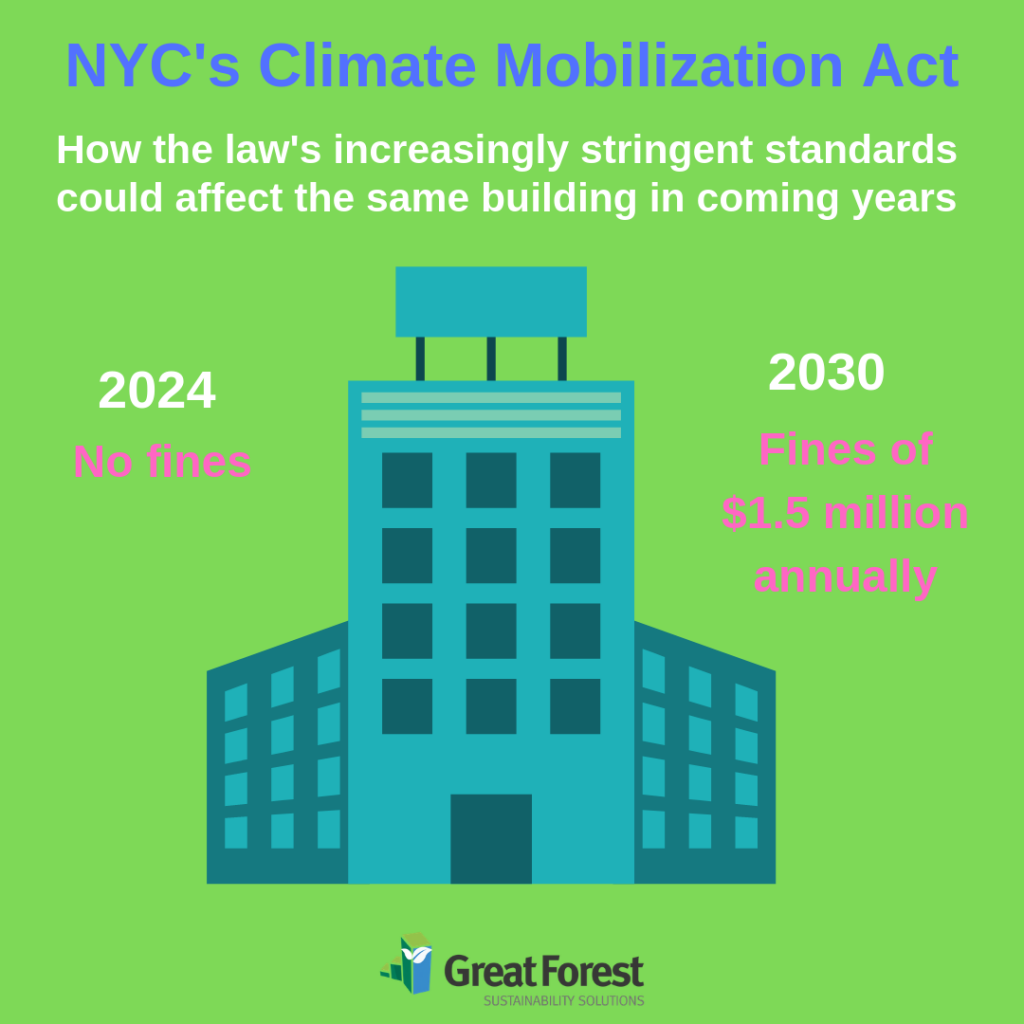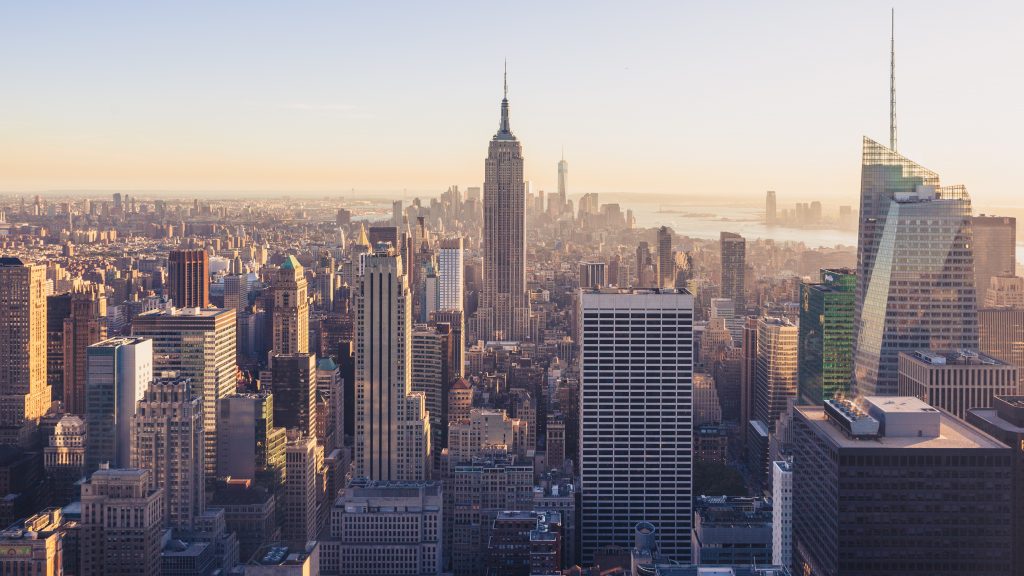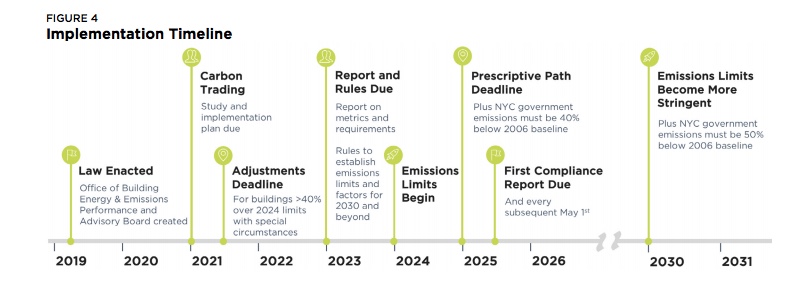
By now most of you will have heard of the Climate Mobilization Act (CMA), signed in May 2019 in NYC, also known as Intro 1253 or Local Law 97 of 2019.
While NYC is one of the first cities in the world to put emissions limits on large buildings over 25,000 square feet, it likely won’t be the last. As the federal government lags behind, more and more local and state lawmakers will start to take the lead as the public demand for more efficient buildings grows. Property owners and managers around the country should take note and prepare. The world is watching what happens in NYC.
Here’s a breakdown of all you need to know.
What is the Climate Mobilization Act?
It is an extensive set of guidelines and penalties for emissions limits from NYC buildings, which sets targets as measured in Metric Tons (mTCO2e/SF) for most types of commercial properties over 25,000 Square Feet.
What is the aim?
To reduce emissions: at a minimum, reduction targets are equivalent to the current total emitted by the entire city of San Francisco (5.3 Million Metric Tons.) NYC hopes to lead the way internationally through the first large municipal mandate of this Green New Deal-type legislation.

What could this mean for you?
- Substantial Penalties: Currently set at $268/Metric Ton over the limit set for each space type individually. Some affordable housing is exempted and instead will be required to install prescriptive measures.
- Increasingly Stringent Standards:
- In 2024, a relatively new (2014) large commercial property built to exceed Code, and deploying some measure of onsite or contracted renewable energy, would avoid penalties.
- In 2030, the same property would begin to be levied at least $1.5 Million annually until additional measures are taken.
- Jobs: Estimates state over 8000 full time positions would be created in construction and maintenance of related measures in just the NYC area.
- Investment: Owner and stakeholder investments are expected to exceed $4 Billion.
What can properties do now?
Re-use energy and space use data already collected under the 2009 Greener, Greater Buildings Plan (GGBP) Local Laws of 2009–LL84/133 for Benchmarking, 87 for Energy Audits and Retro-Commissioning and LL88 for high efficiency lighting and sub-metering. Careful analysis will prepare properties for the strategic planning that is required under LL97(2019). EPA Portfolio Manager guidance on coefficients per fuel type is likely to become more robust too as the 2024 compliance period approaches and more cities follow the lead of NYC.
Multi-use properties should focus attention right away on the relative share of each space type and their respective penalties, which are set for 2024 at 8.46/kg COe for “Group B” (includes commercial offices) versus 6.75/kg COe for multifamily, and ramps down quickly to only 4.53/kg COe for offices and 4.07/kg COe for multifamily in 2030. (One metric ton equals 1000 kg.)
Similarly, equipment useful life plus variables of electric and fuel efficiency projects need to be projected forward at least 10 years. Only with reliable numbers can a property develop a risk assessment under the CMA.
What can properties do for near and long-term planning
For near-term and mid-term efficiency projects: Properties should look into IDSM (Integrated Demand Side Management) delivery, which pulls in energy efficiency, demand response, distributed generation (including storage) and time-based rate programs for coordinated emissions benefits. IDSM projects are starting to gain considerable support among US utilities. Great Forest staff are trained in IDSM with wide-range problem solving skills that can help.
For the long term: Pay attention to alternatives. Also critical to the energy future of cities is the push toward alternatives to natural gas. Along with biofuels for transportation, NYC is considering all alternatives simultaneously to prepare detailed coefficients and standards for offsets by early 2021.
National Grid also has just proposed a Green Gas Tariff which would incentivize pipeline quality gas alternatives (also known as RNG or Renewable Natural Gas) commonly captured from farm waste, industrial by-products, municipal waste or biomass. Markets are already being built around the enormous potential of the RNG technology area. RNG represents the ultimate re-use potential built into urban areas, and its future is strong both directly to properties and as a component of CHP generation (Combined Heat and Power) particularly in the multifamily sector. The largest properties should consider CHP and tariff consultations as the first building block for deployment of alternative fuels.
Things to Watch:
By July 1, NY State Budget proceedings are expected to mandate even more ambitious targets than current, but also include offsets and some carve-out for high emissions industries such as metals fabrication. South Carolina has also floated a new renewable tariff in a historically coal-dependent region. In Minnesota, the Green Gas Tariff opportunity at Centerpoint Energy is now joining Vermont’s historic RNG initiative, which was first in the US.
Twin Issues: Emissions and Zero Waste
Source Emissions are not only critical to the understanding of building operations, they are also the entry point to Zero Waste implementation for all our clients.
According to the World Resource Institute: “For every can of garbage at the curb, there are 87 cans worth of materials that come from the extraction industries—such as timber, agricultural, mining and petroleum—that manufacture natural resources into finished products.”
Wherever source reduction is in focus, both the cost and environmental impact of operations savings can be coordinated and achievable.
As we always say:
…the least expensive kilowatt hour is the one you don’t use.
Timeline

Watch this space for more about the future of the Climate Mobilization Act, waste, and RNG.
Questions? Contact Sheila Sweeney: sheila@greatforest.com
